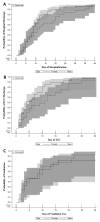Takotsubo Cardiomyopathy and Trauma: The Role of Injuries as Physical Stressors
- PMID: 36046294
- PMCID: PMC9418767
- DOI: 10.7759/cureus.27411
Takotsubo Cardiomyopathy and Trauma: The Role of Injuries as Physical Stressors
Abstract
Introduction: Physical stressors are common predisposing factors for takotsubo cardiomyopathy (TTC). However, the role of traumatic injuries in TTC has not been well defined. This study describes the characteristics of TTC in the broad spectrum of traumatic injuries using the information available in the National Trauma Data Bank (NTDB).
Materials and methods: This retrospective study analyzed trauma patients ≥ 18 years old in the NTDB, from 2007 to 2018, with a diagnosis of TTC.
Results: A total of 95 TTC diagnoses were found. The median age was 68 years old (interquartile range: 55-80). Patients were predominantly female (67.4%), white (88.4%), and sustained blunt mechanisms of injury (90.5%). Penetrating trauma was most common in males (16%). Most diagnoses were related to extremity trauma (53.7%), followed by head injury (26.3%). The most common severity scores were Glasgow Coma Scale (GCS) > 13 or < 8, and Injury Severity Score (ISS) < 15 or > 25. Males more commonly presented with GCS < 8 (68%), ISS > 25 (33%), high intensive care unit (ICU) admission rate (77.4%), and mechanical ventilation (51.6%). The median duration of the mechanical ventilation was eight days for both sexes. The ICU length of stay (LOS) was six days with a hospital LOS of nine days and a trend toward a longer LOS in males. The in-hospital mortality rate was 11.7% for both sexes.
Conclusions: TTC in traumatic injuries is common at both ends of the severity spectrum and has different sex distribution. TTC patients are predominantly females and have more commonly extremity trauma than head injury. Males are more severely injured and under mechanical ventilation.
Keywords: national trauma data bank; physical stressors; stress cardiomyopathy; takotsubo cardiomyopathy; trauma.
Copyright © 2022, Fernandez et al.
Conflict of interest statement
The authors have declared that no competing interests exist.
Figures



References
-
- Epidemiology and pathophysiology of takotsubo syndrome. Akashi YJ, Nef HM, Lyon AR. Nat Rev Cardiol. 2015;12:387–397. - PubMed
-
- Apical ballooning syndrome or takotsubo cardiomyopathy: a systematic review. Gianni M, Dentali F, Grandi AM, Sumner G, Hiralal R, Lonn E. Eur Heart J. 2006;27:1523–1529. - PubMed
LinkOut - more resources
Full Text Sources
